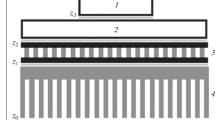Abstract
The results of calculating the characteristics of the heat-transfer process in thermoelectric cooling and temperature control are presented. The influence of the inhomogeneity of the heat flux and thermal contacts on the temperature increase of the heat-loaded element has been defined. The analysis of the cooling efficiency depending on the operating characteristics and the current strength of the power supply of thermoelectric modules, parameters of the heat-loaded element and the individual components of the system, and the conditions of the heat exchange with the external environment has been performed. It has been shown that, under certain conditions, the use of the thermoelectric modules cannot lead to a cooling of the element, but rather to heating. The possibility of optimizing the cooling to reduce the temperature of the heat-loaded element and power consumption of the thermoelectric module has been considered.
Similar content being viewed by others
References
M. A. Sheremet, Mikroelektronika 42, 472 (2013).
G. N. Dul’nev, V. G. Parfenov, and A. V. Sigalov, Methods for Calculation of Thermal Regime of Devices (Radio i Svyaz’, Moscow, 1990).
V. N. Sanin, I. K. Andrekov, A. P. Tsapaev, and N. A. Kopylova, Izv. Vyssh. Uchebn. Zaved., Radioelektron., No. 9, 60 (2003).
V. A. Derevyanko, V. N. Gladushchenko, E. R. Geints, et al., “Thermoelectric cooling module,” RF Patent No. 2511922 (April 10, 2014).
O. I. Markov, Tech. Phys. Lett. 30, 532 (2004).
O. I. Markov, Tech. Phys. 50, 202 (2005).
“Single-stage standard TEM. Technical characteristics.” http://www.osterm.ru/products1.html/
A. A. Samarskii, Theory of Difference Schemes (Nauka, Moscow, 1989).
E. N. Vasil’ev, V. A. Derevyanko, D. A. Nesterov, et al., Vychisl. Tekhnol. 14 (6), 19 (2009).
B. M. Rassamakin, V. A. Rogachev, and S. M. Khairnasov, Tekhnol. Konstr. Elektron. Appar., No. 4, 48 (2006).
E. N. Vasil’ev and V. A. Derevyanko, Vestn. Sib. Gos. Aerokosm. Univ., No. 4, 9 (2013).
Author information
Authors and Affiliations
Corresponding author
Additional information
Original Russian Text © E.N. Vasil’ev, 2017, published in Zhurnal Tekhnicheskoi Fiziki, 2017, Vol. 87, No. 1, pp. 80–86.
Rights and permissions
About this article
Cite this article
Vasil’ev, E.N. Calculation and optimization of thermoelectric cooling modes of thermally loaded elements. Tech. Phys. 62, 90–96 (2017). https://doi.org/10.1134/S1063784217010248
Received:
Accepted:
Published:
Issue Date:
DOI: https://doi.org/10.1134/S1063784217010248




